Java 优先级队列
/少司命 人气:0一,二叉树的顺序存储
①存储方式
使用数组保存二叉树结构,方式即将二叉树用层序遍历方式放入数组中。 一般只适合表示完全二叉树,因为非完全二叉树会有空间的浪费。 这种方式的主要用法就是堆的表示。
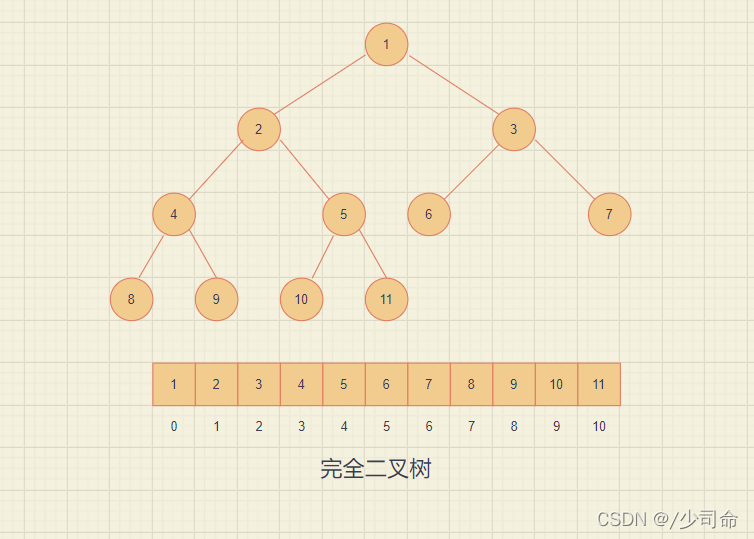
②下标关系
已知双亲(parent)的下标,则:
左孩子(left)下标 = 2 * parent + 1;
右孩子(right)下标 = 2 * parent + 2;
已知孩子(不区分左右)(child)下标,则:
双亲(parent)下标 = (child - 1) / 2;
③二叉树顺序遍历

// 层序遍历
void levelOrderTraversal(TreeNode root) {
if(root == null) {
return;
}
Queue<TreeNode> queue = new LinkedList<>();
queue.offer(root);
while (!queue.isEmpty()) {
TreeNode top = queue.poll();
System.out.print(top.val+" ");
if(top.left != null) {
queue.offer(top.left);
}
if(top.right!=null) {
queue.offer(top.right);
}
}
System.out.println();
}
二,堆
①概念
1. 堆逻辑上是一棵完全二叉树
2. 堆物理上是保存在数组中
3. 满足任意结点的值都大于其子树中结点的值,叫做大堆,或者大根堆,或者最大堆
4. 反之,则是小堆,或者小根堆,或者最小堆
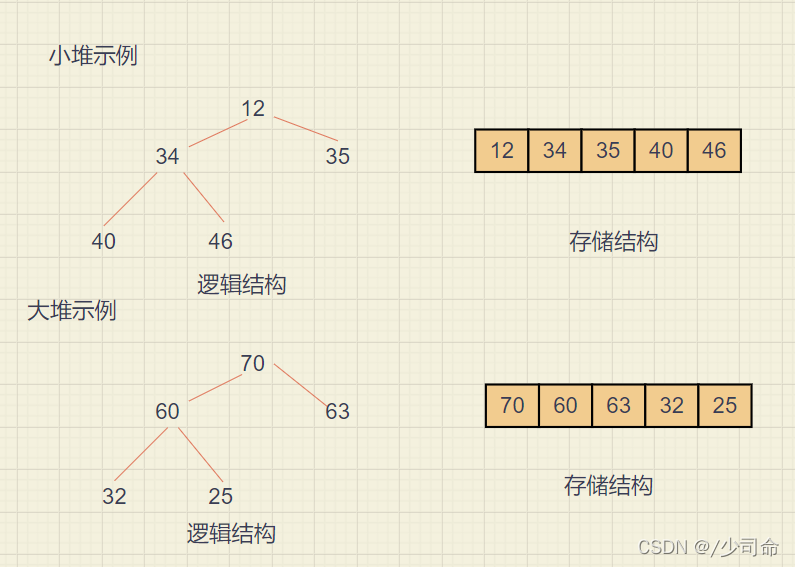
②操作-向下调整
前提:
左右子树必须已经是一个堆,才能调整。
说明:
1. array 代表存储堆的数组
2. size 代表数组中被视为堆数据的个数
3. index 代表要调整位置的下标
4. left 代表 index 左孩子下标
5. right 代表 index 右孩子下标
6. min 代表 index 的最小值孩子的下标
过程(以小堆为例):
Ⅰ index 如果已经是叶子结点,则整个调整过程结束
1. 判断 index 位置有没有孩子
2. 因为堆是完全二叉树,没有左孩子就一定没有右孩子,所以判断是否有左孩子
3. 因为堆的存储结构是数组,所以判断是否有左孩子即判断左孩子下标是否越界,即 left >= size 越界
Ⅱ 确定 left 或 right,谁是 index 的最小孩子 min
1. 如果右孩子不存在,则 min = left
2. 否则,比较 array[left] 和 array[right] 值得大小,选择小的为 min
Ⅲ比较 array[index] 的值 和 array[min] 的值,如果 array[index] <= array[min],则满足堆的性质,调整结束
Ⅳ否则,交换 array[index] 和 array[min] 的值
Ⅴ然后因为 min 位置的堆的性质可能被破坏,所以把 min 视作 index,向下重复以上过程
向下调整是以层序遍历的二叉树为例来遍历

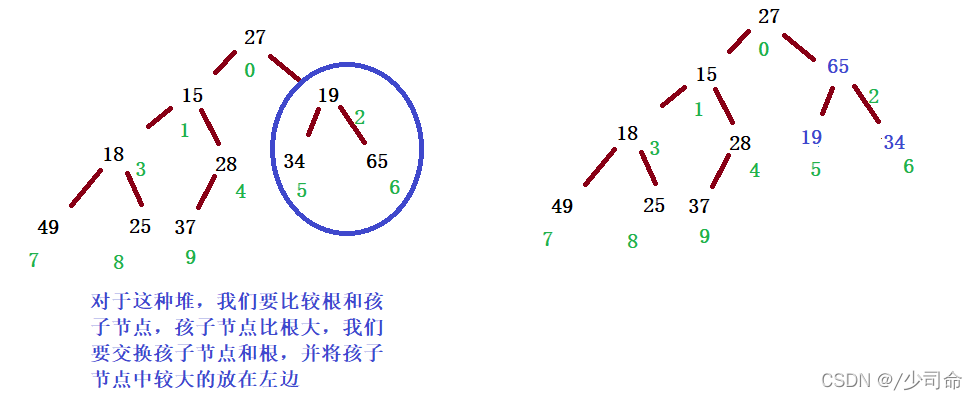
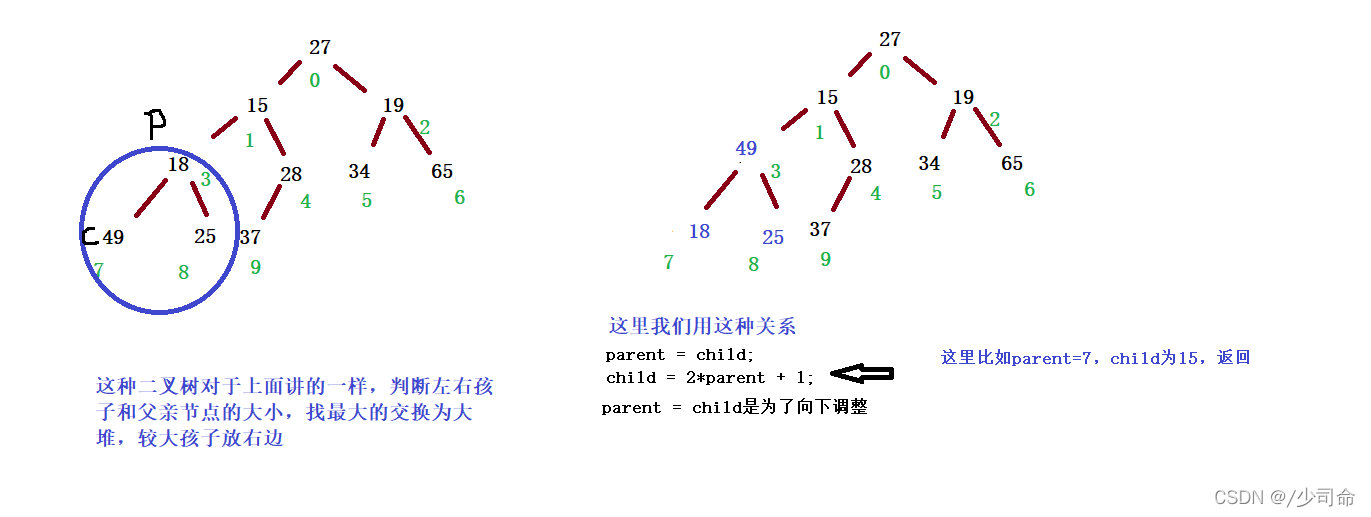
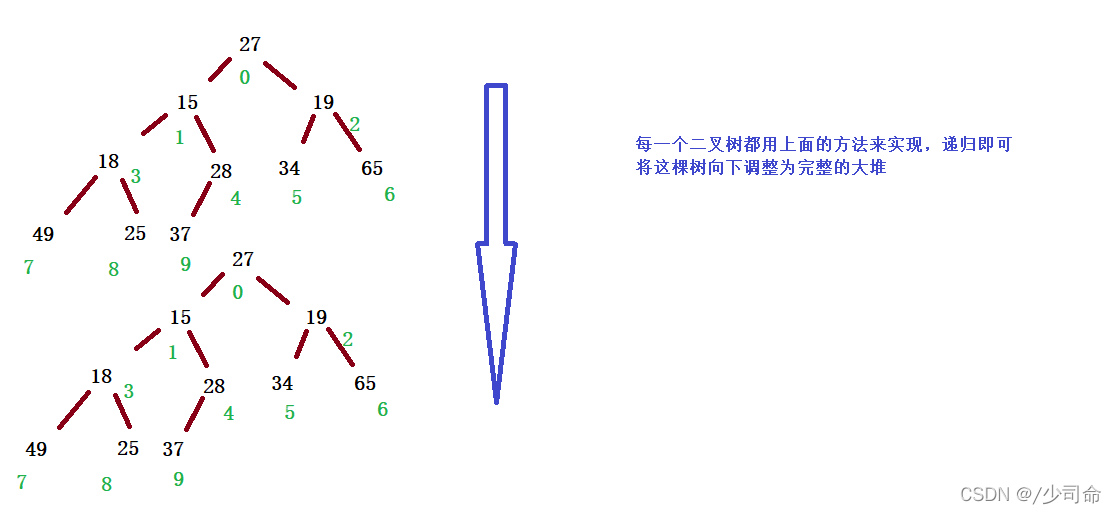
public void adjustDown(int root,int len){
int parent = root;
int child = 2*parent + 1;
while(child < len){
if (child + 1 < len && this.elem[child] < this.elem[child + 1] ){
child++;
}
if(this.elem[child] > this.elem[parent]){
int tmp = this.elem[parent];
this.elem[parent] = this.elem[child];
this.elem[child] = tmp;
parent = child;
child = 2*parent + 1;
}else{
break;
}
}
}
③建堆(建大堆为例)
下面我们给出一个数组,这个数组逻辑上可以看做一颗完全二叉树,但是还不是一个堆,现在我们通过算法,把它构 建成一个堆。根节点左右子树不是堆,我们怎么调整呢?这里我们从倒数的第一个非叶子节点的子树开始调整,一直 调整到根节点的树,就可以调整成堆。
//建大堆
public void creatHeap(int[] array){
for (int i = 0; i < array.length;i++){
this.elem[i] = array[i];
suedSize++;
}
for (int parent = (array.length - 1 - 1) / 2;parent >= 0;parent--){
adjustDown(parent,this.suedSize);
}
三,堆的应用-优先级队列
①概念
在很多应用中,我们通常需要按照优先级情况对待处理对象进行处理,比如首先处理优先级最高的对象,然后处理次 高的对象。最简单的一个例子就是,在手机上玩游戏的时候,如果有来电,那么系统应该优先处理打进来的电话。 在这种情况下,我们的数据结构应该提供两个最基本的操作,一个是返回最高优先级对象,一个是添加新的对象。这 种数据结构就是优先级队列(Priority Queue)
②内部原理
优先级队列的实现方式有很多,但最常见的是使用堆来构建。
③入队列
过程(以大堆为例):
1. 首先按尾插方式放入数组
2. 比较其和其双亲的值的大小,如果双亲的值大,则满足堆的性质,插入结束
3. 否则,交换其和双亲位置的值,重新进行 2、3 步骤 4. 直到根结点

public void adjustUp(int child){
int parent = (child - 1) / 2;
while(child>0){
if(this.elem[child] > this.elem[parent]){
int tmp = this.elem[parent];
this.elem[parent] = this.elem[child];
this.elem[child] = tmp;
child = parent;
parent = (child - 1) / 2;
}else {
break;
}
}
}
public void push(int val) {
if (isFull()) {
this.elem = Arrays.copyOf(this.elem, 2 * this.elem.length);
this.elem[this.suedSize] = val;
this.suedSize++;
adjustUp(this.suedSize - 1);
}
}
④出队列(优先级最高)
为了防止破坏堆的结构,删除时并不是直接将堆顶元素删除,而是用数组的最后一个元素替换堆顶元素,然后通过向下调整方式重新调整成堆
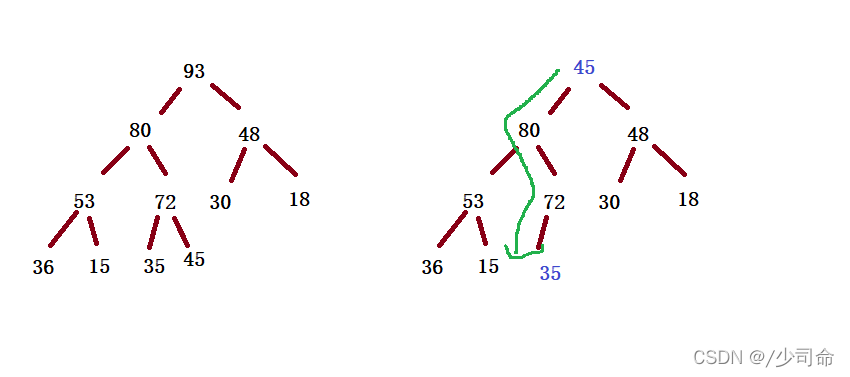
public boolean isEmpty(){
return this.suedSize == 0;
}
public void pop(){
if(isEmpty()){
return;
}
int tmp = this.elem[0];
this.elem[0] = this.elem[this.suedSize-1];
this.elem[this.suedSize-1] = tmp;
this.suedSize--;
adjustDown(0,this.suedSize);
}
⑤返回队首元素(优先级最高)
public int peek(){
if(isEmpty()){
return -1;
}
return this.elem[0];
}
public boolean isFull(){
return this.suedSize == this.elem.length;
}
四,堆排序
/**
* 一定是先创建大堆
* 调整每棵树
* 开始堆排序:
* 先交换 后调整 直到 0下标
*/
public void heapSort(){
int end = this.suedSize-1;
while (end > 0){
int tmp = this.elem[0];
this.elem[0] = this.elem[end];
this.elem[end] = tmp;
adjustDown(0,end);
end--;
}
}
加载全部内容